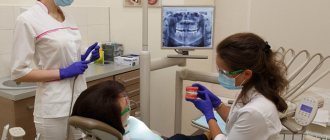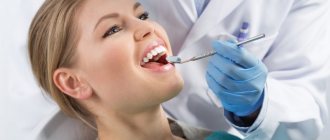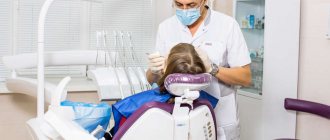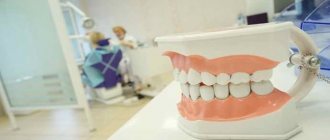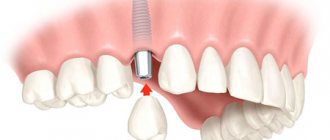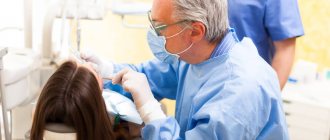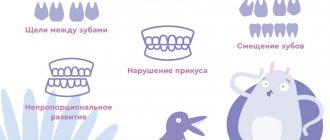The dental industry is considered one of the most popular and relevant in medicine. It is developing rapidly and opening up many new industries for implementation. Dentists not only treat and remove teeth, but also eliminate various aesthetic defects and advise patients on proper care.
Orthodontics is a promising dental field in the modern world. Many applicants choose this industry at the admission stage. They are looking for information about educational institutions that train orthodontists, about the advantages and disadvantages of this specialty. Graduates are interested in the questions: “How to become an orthodontist?”, “What are the main responsibilities of employees?” and “How and when can I go to study?”
Our assessment of the profession
6
Demand
7.0/10
Salary
9.0/10
Is it “easy” to get a profession?
2.0/10
Kudos
9.0/10
Career
3.0/10
For toothaches and other problems that arise in the oral cavity, people turn to dentists. Few patients know that their doctor with a different name is treating them. After all, practical dentistry combines several areas, such as therapy, orthopedics, surgery, and orthodontics. And, if with the first specialties everything is clear by name, then the specifics of the work of an orthodontist raises questions. What does this doctor do, when should you contact him and how to get a profession?
Who is called an orthodontist and what functions does the doctor perform?
An orthodontist is a “beautiful smile” doctor. This is how one can characterize all his activities aimed at correcting congenital or acquired jaw defects and solving aesthetic problems. Injuries, incorrect (pathological) bite, abnormalities of curved teeth, displacement of dentition, facial asymmetry - this is a small list of problems with which patients turn to an orthodontist. A visit to this specialist is also necessary before the prosthetic procedure.
The main tasks of an orthodontist:
- research into the causes that led to the formation and development of pathologies (congenital, hereditary or acquired);
- determination and analysis of the level of complexity of the patient’s problem;
- drawing up an adequate and effective course of treatment for the detected pathology, based on the individual characteristics of the patient and the diagnosis;
- carrying out measures to prevent further development or recurrence of the anomaly in the patient;
- records management;
- if necessary, performing dental procedures: tooth extraction, pain relief;
- providing first aid if the patient needs it.
Orthodontists are required to tell patients about the rules of oral hygiene. These specialists install braces, make impressions and determine the parameters of dentures.
Orthodontists are divided into children's and adults, because problems with jaw anomalies occur at any age. However, treatment methods for adult patients and children differ.
Main directions of orthodontic treatment
The difficulty of an orthodontist’s work lies in the fact that he must carefully study the clinical picture and choose the most appropriate methods for correcting defects that will give a guaranteed result. Here are three main areas of treatment, the choice of which depends on the complexity of the pathology:
- myotherapy is a special gymnastics for the jaw system. It is used for small patients who cannot yet have corrective devices installed, as well as for adults in order to maintain the effect achieved by treatment with braces,
Gymnastics for the jaw is prescribed if it is too early for a child to get braces. - hardware methods - involve the use of removable or non-removable systems, such as orthodontic plates, braces, mouth guards, aligners and others, which need to be worn from six months to several years. During this time, the patient will have to periodically visit the specialist’s office for correction of the device,
Braces will help correct your bite - surgical intervention - the need for it arises only in rare cases when the doctor has to deal with a complex and serious anomaly. In some situations, it is necessary to make an incision on the mucous membrane and artificially expand the dental arch. True, it is not the orthodontist who deals with surgery, but the maxillofacial surgeon (but in no case just a dental surgeon!) Surgical correction of the bite
As mentioned above, only a specialist can choose the appropriate method for correcting existing defects. It is also important to establish trusting contact between the specialist and the patient, because the course of treatment can take more than one year. The orthodontist must simply and clearly explain all the nuances of oral care after installing braces and explain that a large share of responsibility for the result lies on the shoulders of the patient. The same, for his part, must strictly follow all the instructions and prescriptions of the doctor if he wants to achieve maximum results.
Differences in the work of a pediatric orthodontist
As soon as the baby's first teeth appear, he can be taken to see an orthodontist if the parents are concerned about something. The period from 6 months to 1.5-2 years, while baby teeth are being cut, is considered the most successful for correcting jaw pathologies. After all, it is at this moment that the bite, and the dental system as a whole, is formed.
The sooner abnormalities are diagnosed, the easier it will be to get rid of them without using medications.
The tasks of a pediatric orthodontist include:
- study of late eruption or loss of primary teeth and treatment of such anomalies;
- prescribing a treatment plan and monitoring the patient’s condition at all stages;
- installation of mouthguards or braces for adolescents with a violation of the molar bite (not earlier than 11 years).
What does he do?
What the patient voices in a few phrases: “uncomfortable chewing,” “ugly smile,” or “bad bite,” is one of many pathologies for the orthodontist.
Crooked teeth
An anomaly of one or several teeth, as well as the relative position of the rows of the upper and lower jaw, can occur by inheritance, as a result of using the wrong pacifier or pacifier in infancy, due to caries of baby teeth, due to mouth breathing, bad habits, etc. .
Conical or awl-shaped teeth
They are cone-shaped, sometimes resembling the fangs of predatory animals. Most often these are fangs, straight or lateral incisors. This form can develop with partial edentia, supernumerary, and also occurs with normal completeness.
Hypoplasia
Underdevelopment of the tooth or its individual tissues in varying forms and degrees occurs in approximately every third person.
The extreme degree of hypoplasia is aplasia - the congenital absence of individual tissues or the entire tooth. Enamel hypoplasia is the most common, with primary teeth affected less frequently than permanent teeth.
Enamel dysplasia
It is expressed in the unnatural color of the enamel during growth or its darkening later. Over the years, it can become cracked and easily chipped under mechanical stress.
The second type of this pathology is thinned enamel, which quickly wears away, exposing dentin (crownless form).
As a rule, in such cases, sensitivity is reduced, and the patient suffers more from damage to the gums and oral mucosa by the sharp edges of the teeth.
Dentin dysplasia (dentinogenesis imperfecta)
Pathological changes in dentin, expressed in the incorrect location of the tubules, and sometimes in their complete absence.
It can be combined with general damage to the musculoskeletal system of the body. The enamel may take on an amber tint and is often chipped; with this anomaly, teeth are weakly secured and fall out early.
Macrodentia
Pathology of unknown etiology, expressed in large teeth. It is assumed to be hereditary. Most often it affects the central incisors of the upper row.
Sometimes the anomaly occurs due to the fusion of adjacent follicles, in which one is usually incomplete (supernumerary).
Macrodentia is diagnosed when the total length of the crowns of the four upper incisors is ≥35 mm, and the lower ones - ≥27 mm.
Microdentia
A fairly rare anomaly in which the crown is reduced. The proportions may not be affected, or the pathology may be aggravated by the conical shape of the crown. Types of microdentia:
- isolated, in which one tooth (or more often two symmetrically) has abnormal dimensions, usually concerns the upper incisors;
- generalized, resulting from irradiation during growth;
- relative - an imbalance of normal tooth sizes with a powerful jaw.
The negative consequences of microdentia are malocclusion, aesthetics and associated complexes.
Merged teeth
An anomaly in which the dentin of two adjacent permanent or primary teeth fuses to form a common enamel shell. Partial fusion is possible - in the root or crown area.
Edentia
Complete or significant absence of teeth. There are primary and secondary adentia. Primary occurs for various reasons during the embryonic period and consists in the initial absence of rudiments.
Secondary adentia is the loss of teeth by an adult due to dental diseases or injuries.
Hypodentia
Congenital or acquired absence of individual teeth. On a more global scale, it is diagnosed as adentia.
Hyperodentia
Pathology expressed by the presence of supernumerary primary or permanent teeth. Presumably associated with autosomal dominant inheritance.
Additional teeth can be located either in the main row or pushed out of it. Often they are so submerged (retention) that they do not protrude from the gums and can only be detected using x-rays.
Retention
Pathology of teeth that, due to various reasons, could not erupt and remained under the gum. Main reasons:
- various diseases that have led to weakening of the body;
- disturbances during artificial feeding;
- delayed loss of baby teeth;
- incorrect location of the rudiment - the coronal part abuts the adjacent root or other obstacle (supernumerary formations, etc.).
Preserved milk teeth (persistent)
The anomaly consists in the preservation of a baby tooth until the age when it should already fall out. There may be several reasons - the absence of a permanent rudiment under the milk, growth to the jaw, etc.
The baby tooth does not necessarily need to be removed. If it is discovered that for some reason the permanent one cannot replace it, then a decision is made to retain it.
The nature of a baby tooth is not designed to last long, but with good care it can easily be used until age 50 or even beyond.
Gap between front teeth (diastema)
Most often found on the upper jaw. The size of a large diastema can reach 10 mm.
The most common cause is low attachment of the labial frenulum, which is easily corrected in childhood. In addition to a purely aesthetic problem, it can also lead to the following consequences:
- exposure of roots;
- pronunciation defects (especially whistling sounds).
Tremes
Presence of a gap between the teeth. Unlike a diastema, tremata can be located in different places. The etiology is often hereditary.
Shortening of the dentition
It occurs in its different parts as a result of teeth not fully erupting, their uneven wear, bad habits (thumb sucking, pencil sucking, etc.), carious and non-carious lesions, injuries, etc. Pathology disrupts the bite and aesthetic appearance.
Our article will help you find out the price of oral sanitation, as well as understand the essence and importance of the procedure. And here you can see not only a photo of what a normal bite looks like in a person, but also read about the features of its correct formation.
Elongation of the dentition
May have the following reasons:
- mouth breathing, swallowing dysfunction;
- bad habits - sucking fingers, lips, foreign objects;
- supernumerary, remaining milk teeth in the presence of all permanent teeth;
- diastema, trema, etc.
Dentoalveolar shortening
Leads to an open bite. Probable causes are bad habits, caries, etc.
Dentoalveolar elongation
Pathology of the dentition, leading to malocclusion, protrusion or retrusion. In one row it can be combined with dentoalveolar shortening.
Narrowing or widening of the jaw dentition
This is a decrease or increase in transverse size. Occurs on one or two jaws (dentition), uniform along the entire length or on one of the parts, symmetrical or one-sided.
In the latter case, a crossbite is formed. A narrowing of the row may be a consequence of crowding of the front teeth, their curvature, protrusion, etc.
If the anomaly is symmetrical on both jaws, the decision on the need for correction is made by the doctor in each case separately.
High and low position of individual teeth (supraocclusion and infraocclusion)
Pathology expressed in the vertical displacement of one or more teeth . A high position is possible due to the removal of the antagonist in childhood, a low position is a violation of the resorption of the root of a temporary tooth, which inhibits the growth of a permanent one.
Distal bite (prognathic)
It is characterized by the advancement of the top row forward in comparison with the bottom. An external sign is a small chin, creating a childish and hesitant expression.
With such a bite, the load on the molars increases, as a result of which they are more often affected by caries.
Mesial bite (medial)
The bottom row protrudes forward in comparison with the top, which pushes the chin, making the face strong-willed or arrogant.
This pathology is striking in women, depriving the face of attractiveness. As with a distal bite, the root part suffers when chewing.
Open bite
The jaw does not close in the anterior and/or lateral sections. It can manifest itself over a long period or in separate groups. This pathology is considered one of the most difficult to correct in orthodontics.
Crossbite
Asymmetrical development of one side of the row. It can be on both the upper and lower jaw.
Chewing functions are impaired - often the patient chews on one side , which as a result is susceptible to caries and periodontal diseases.
The load on the temporomandibular joint also increases, which is fraught with the occurrence of pathological changes in it.
Deep (traumatic bite)
A pathology in which the top row in the front (possibly also in the side) part overlaps the bottom by more than half.
In this case, the mucous membrane constantly receives microtraumas; cases of periodontitis and periodontal disease are more frequent.
Advantages and disadvantages
The profession of an orthodontist is one of the most popular specialties in any clinic or hospital in Russia. Specialists have a high salary; in addition, monthly earnings can increase by receiving bonuses or bonuses. Additional advantages of the profession include:
- constant availability of work, because the number of patients with jaw problems is large;
- lack of heavy physical labor;
- excellent students with high Unified State Exam scores get the opportunity to become applicants to higher educational institutions for free; budget places are also available in residency;
- a large number of regular customers.
Disadvantages of orthodontists:
- high level of responsibility;
- nervous tension;
- long period of training;
- low level of wages in public medical institutions.
How does the first appointment with a specialist go?
At the first appointment, no one will install braces or a corrective plate - this is simply impossible to do without prior preparation. Thus, the first visit to a specialist involves a visual examination, preliminary diagnosis of possible problems and consultation on suitable methods for solving them.
The photo shows a panoramic shot of the jaw
To make the final choice in favor of one method or another, the doctor must obtain an x-ray of both jaws of the patient. For this purpose, he is required to undergo an orthopantomogram (OPTG)1. Only upon completion of all diagnostic measures, the doctor takes impressions of the patient’s jaws and sends them to the laboratory to create or adjust a corrective apparatus. Once the structure is ready, the orthodontist will install it and explain to the patient his further actions.
Where to get education
Obtaining the profession of an orthodontist is a long process. First, you need to obtain a specialized dental education at any medical higher education institution in the country. The training will last 5 years.
For successful admission, applicants must provide high results on the Unified State Exam or pass tests in the following disciplines: mathematics, physics, chemistry, biology. Some universities also require a foreign language exam. The list of subjects should be clarified at a specific educational institution.
The best universities in Russia that graduate dentists are:
- Lomonosov Moscow State University;
- RUDN;
- Siberian State Medical University;
- First Moscow State Medical. Sechenov University;
- St. Petersburg State University;
- KubSMU and others.
Applicants who show the best results in the exams can expect to enroll for free. However, there are not many budget places in medical universities - about 20.
After receiving a specialized dental education, the graduate must continue his residency training in the specialization of orthodontist. This takes another 4 years.
After receiving a retraining certificate, the orthodontist can begin to practice. Every 5 years, doctors in this specialty are required to take advanced training courses. The courses are conducted both part-time and remotely, so that the dentist is not distracted from his professional activities.
Where to find a job
Orthodontists are a sought-after profession in the labor market. A dentist can work in orthodontic departments located in children's and adult clinics or hospitals. Orthodontist vacancies are open in many medical centers, studios, and aesthetic medicine clinics. An experienced orthodontist with a long-term practice can open his own private office to provide dental services.
In addition, orthodontists who do not have a desire to interact with patients have the opportunity to get work in enterprises involved in the sale or manufacture of medicines, medical devices or equipment.
How long to study to become a dentist after grades 9 and 11
As we said earlier, you can study the “dental craft” both after the ninth and after the eleventh grade. However, this also has its own characteristics.
You can start studying after 9th and 11th grade
After the ninth grade, you only have the right to go to college and receive a secondary specialized education there.
When you graduate from college, you won't be given a dentist's degree. In such an educational institution you can master the specialty of a dental technician.
As such, you will not have any work with patients related to pulling out teeth, prosthetics, or removing stones.
Your activity will consist of manufacturing all kinds of devices and devices that facilitate direct dental activities related to the treatment of patients.
By the way, don’t think that getting this specialty is easy. You will need to have a good understanding of medicine, be able to draw (models of future products), and know the basics of design science, chemistry and biology.
Requirements for the applicant
In addition to having a higher education diploma, the employer pays attention to the following professional qualities of the applicant:
- knowledge of the principles of drug use in orthodontic treatment;
- ability to classify dentofacial pathologies;
- knowledge in the field of fixed and removable orthodontic appliances;
- ability to use methods for studying and treating anomalies;
- knowledge in the field of physiotherapy;
- skills in working with x-rays, articulators, endomotors, and visiographs;
- possession of a personal computer.
The orthodontist is also required to know emergency first aid techniques.
In addition to high knowledge in the professional field, the orthodontist must have suitable personal qualities. As a rule, both adults and children are a little afraid of dentists. An orthodontist, unlike his colleagues, dental therapists, has to be seen by patients much more often during the treatment period. This means that the doctor must inspire confidence and be able to win over you. Tolerance, diligence and communication skills are important qualities for a professional.
In addition, the specialist must have perfect vision and developed fine motor skills.
Brief job description
When performing his official duties, the orthodontist is obliged to rely on documents regulating his rights and obligations, and to fulfill the prescribed requirements, namely:
- higher medical education in the field;
- knowledge of the basics of the legislative framework, the content of regulations;
- possession of proper tools and equipment;
- a set of necessary theoretical knowledge and practical skills;
- carrying out diagnostics, correction, treatment, prevention, etc.;
- familiarity with the procedure and organization of work, understanding of the structure, awareness of the tasks of the orthodontic service;
- planning activities, maintaining documentary reports;
- knowledge of safety rules, labor protection standards, sanitation, fire protection;
- compliance with internal labor regulations established by the organization’s management;
- control, responsibility for the work of subordinate personnel.
Wage
An orthodontist's salary depends on many factors. This is both a qualification level and experience in practice. The average salary in Russia is 60 thousand rubles. The minimum salary is 30 thousand per month, the maximum salary of a high-level specialist can reach up to 300 thousand rubles per month. As a rule, orthodontists in private clinics receive a higher salary rate compared to public institutions.
When hiring, many employers give orthodontists a probationary period (3 months according to labor law). The wage rate at this time is 25-30 thousand rubles per month.
Orthodontic dental assistants can count on an average salary of 25 thousand rubles.
The data is current as of October 2021 and taken from the Yandex Job service.
Professional growth
An orthodontist, like other representatives of medical professions, is assessed according to qualification criteria. The longer he practices, the higher his chances of receiving a salary increase and career advancement. Orthodontists who have worked for more than 3 years receive the second category, and over 7 years - the first. The highest qualification is awarded to specialists who have been working for more than 10 years. A doctor has the right to refuse to undergo advanced training tests. In this case, you won’t have to count on career growth.
In clinics and hospitals, an orthodontist with extensive work experience and high qualifications can obtain a position as head of an orthodontic or dental department. In private clinics, promotion as such is not provided. However, having gained considerable experience, a specialist can find a job in a more respectable private clinic or open his own office.
The profession of orthodontist requires extensive training. Moreover, the main role is not the theoretical basis, but practice. An orthodontist needs to constantly accumulate practical experience, increase the level of knowledge and skill. Seminars, courses and other events aimed at broadening the specialist’s horizons will help with this. Diligence, hard work, and a friendly attitude towards patients will help a novice doctor quickly build a career and earn the respect of colleagues and clients.
Important personal qualities
The most important thing here is the psychological factor. Dental correction is a long process. It takes from 6 months to 2-3 years. And most often you have to deal with children. Therefore, you need to be able to establish trusting contact with them. You can’t do this without the ability to empathize and communicate.
Stress resistance and the ability to smooth out conflict situations are also valued. And in order for the treatment results to always be positive, you need to take your work responsibly. Hard work also requires goodwill, balance and tact.
And no less significant will be the desire for self-development. A specialist must regularly improve his competence and skill level , and understand new treatment methods.
